The NVIDIA GeForce GTX 1660 Review, Feat. EVGA XC GAMING: Turing Stakes Its Claim at $219
by Ryan Smith & Nate Oh on March 14, 2019 9:01 AM ESTPower, Temperature, and Noise
As always, we'll take a look at power, temperature, and noise of the GTX 1660, though after having seen the GTX 1660 Ti in a similar if not identical design, we aren't expecting anything out of the ordinary. As mentioned earlier, we've seen the XC Black board with the GTX 1660 Ti not too long ago.
Using the same TU116 GPU as the GTX 1660 Ti, the voltages are unsurprisingly the same.
| NVIDIA GeForce Video Card Voltages | ||
| Model | Boost | Idle |
| GeForce GTX 1660 | 1.037V | 0.656V |
| GeForce GTX 1660 Ti | 1.037V | 0.656V |
| GeForce RTX 2060 | 1.025v | 0.725v |
| GeForce GTX 1060 6GB | 1.043v | 0.625v |
As for clockspeeds, the same broad points from the GTX 1660 Ti review apply. Clocks at +10W TDP and at reference 120W TDP are only slightly altered, and the trend of NVIDIA's conservative boost estimates continues.
| GeForce Video Card Average Clockspeeds | |||||
| Game | GTX 1660 | EVGA GTX 1660 XC |
GTX 1660 Ti | GTX 1060 6GB | |
| Max Boost Clock |
2160MHz
|
2160MHz |
2160MHz
|
1898MHz
|
|
| Boost Clock | 1830MHz | 1830MHz | 1770MHz | 1708MHz | |
| Battlefield 1 | 1880MHz | 1885MHz | 1888MHz | 1855MHz | |
| Far Cry 5 | 1889MHz | 1897MHz | 1903MHz | 1855MHz | |
| Ashes: Escalation | 1874MHz | 1872MHz | 1871MHz | 1837MHz | |
| Wolfenstein II | 1832MHz | 1861MHz | 1825MHz | 1835MHz | |
| Final Fantasy XV | 1865MHz | 1869MHz | 1855MHz | 1850MHz | |
| GTA V | 1894MHz | 1898MHz | 1901MHz | 1872MHz | |
| Shadow of War | 1879MHz | 1882MHz | 1860MHz | 1861MHz | |
| F1 2018 | 1880MHz | 1886MHz | 1877MHz | 1865MHz | |
| Total War: Warhammer II | 1890MHz | 1893MHz | 1908MHz | 1875MHz | |
Compared to the official average boost clock of the GTX 1660 Ti, the differences are also minor.
Power Consumption

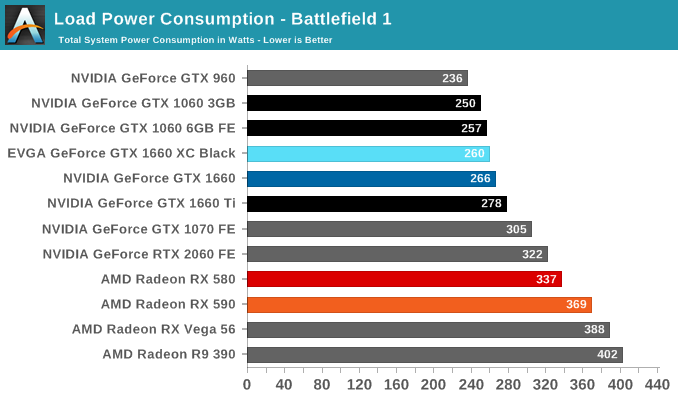
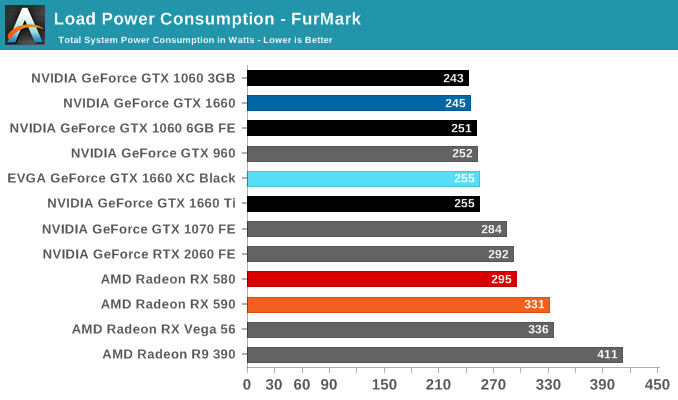
Meanwhile when it comes to idle power consumption, the GTX 1660 falls in line with everything else at 83W. With contemporary desktop cards, idle power has reached the point where nothing short of low-level testing can expose what these cards are drawing.
All told, NVIDIA has very good and very consistent power control here. and it remains one of their key advantages over AMD, and key strengths in keeping their OEM customers happy.
Temperature

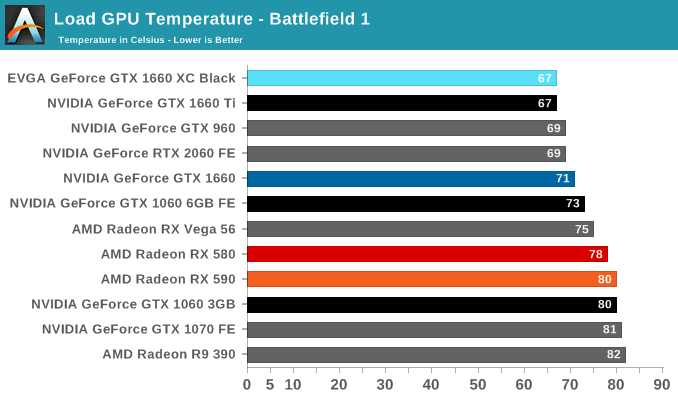
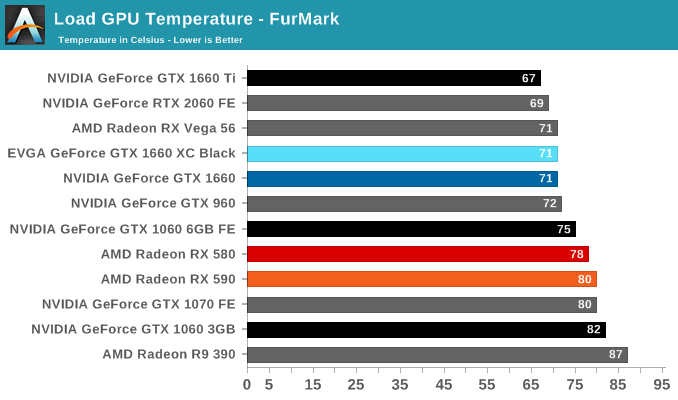
Noise
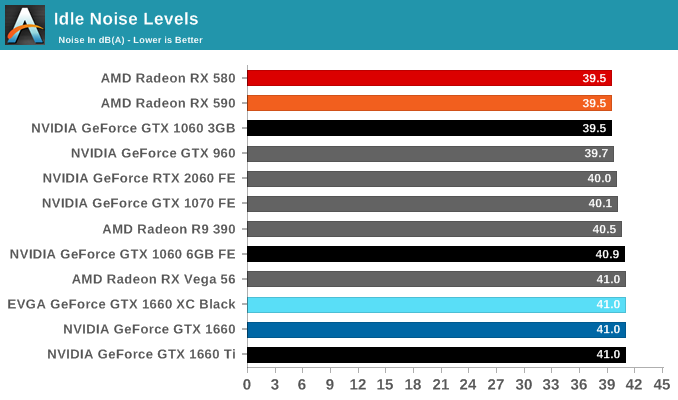
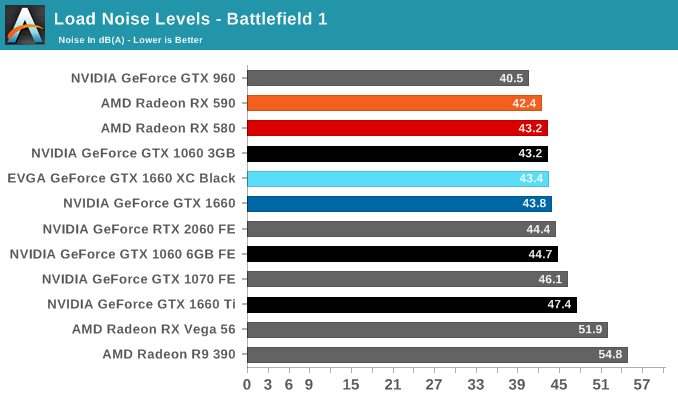
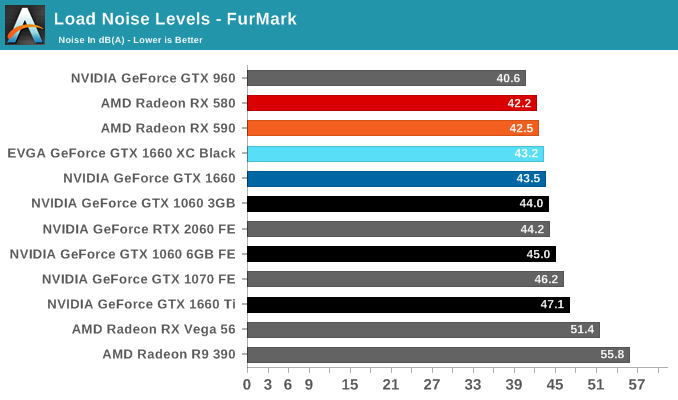
Turning again to EVGA's card, despite being a custom open air design, the GTX 1660 XC Black doesn't come with 0db idle capabilties and features a single smaller but higher-RPM fan. The default fan curve puts the minimum at 33%, which is indicative that EVGA has tuned the card for cooling over acoustics. But the curve is a little more forgiving at higher temperatures, and doesn't ramp up as much, reducing their noise levels significantly from the Ti XC Black.










77 Comments
View All Comments
Qasar - Sunday, March 17, 2019 - link
ebay is not really an answer, as some.. may not want to deal with the hassle of ebay, or even have an ebay account. and now a days, not all games can be resold. but that still doesnt add any " value " to the video card by adding specific games...romrunning - Thursday, March 14, 2019 - link
Triple-slot coolers pretty much kill it for mini-ITX systems. Usually they only have room for double-slot at most.damianrobertjones - Thursday, March 14, 2019 - link
Second hand 1070 all... day... long.TheCurve - Thursday, March 14, 2019 - link
Great review guys, loved it!Tilmitt - Thursday, March 14, 2019 - link
If you actually want these reviews to be useful to real people making actual upgrade decisions, you need to include far more older GPUs. All the mid and high end GPUs from the 700 and 900 series at least. Preferably an awful lot more than this.Ryan Smith - Thursday, March 14, 2019 - link
It's always a fine balance between including older cards for context, and newer cards to showcase how it actually compares to other things you can buy (and the product it directly replaces). In this case we do have the GTX 960 and the R9 390 in these graphs; meanwhile for everything else, Bench can give you whatever comparisons you're looking for.https://www.anandtech.com/bench/GPU18/2293
Tilmitt - Friday, March 15, 2019 - link
Unless I'm doing it wrong, bench is useless because the cards people want to compare aresegregated into different bench years so you can't actually compare them. How does one compare a 770 and a 1660?
Ryan Smith - Friday, March 15, 2019 - link
Fair enough point on the Kepler cards. We haven't gone in and backfilled those yet. However all of the 900 series cards are in there.Hrel - Tuesday, March 19, 2019 - link
Doesn't seem to be any way to compare the R9 280x to the 1660 either, or the GTX1070.zeroidea - Monday, March 18, 2019 - link
If all the benchmark data is in a database, might it be possible to make the charts dynamic, and have an "add card to this graph" option? Better yet, store a user's personal system (or import it from pcpartpicker) and do this automatically for logged-in users, since this is what a lot of people care about (and currently open multiple tabs to different websites in order to accomplish the same thing). That's the kind of value-add that'd get me to cough up a bit for a premium membership, if AT ever wanted to go down that route.